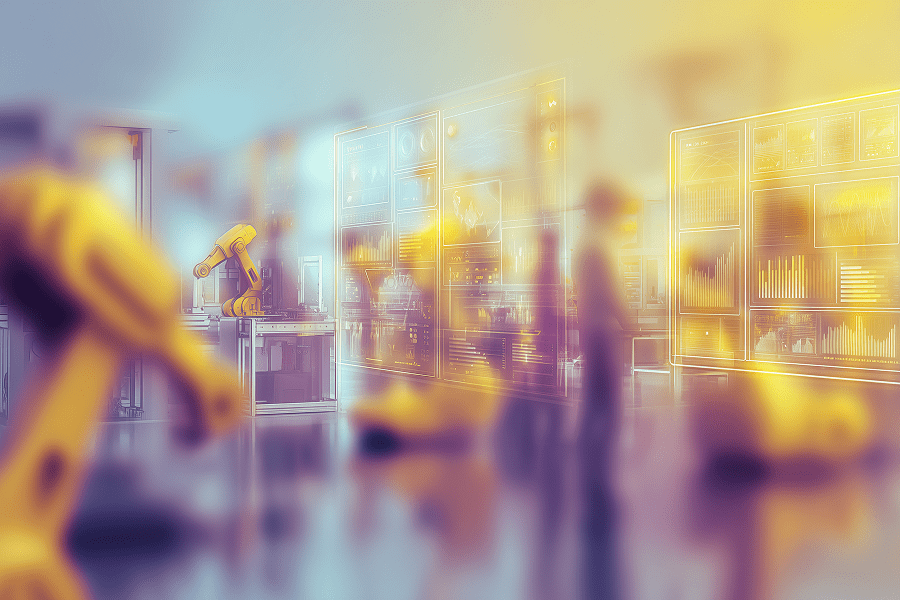Home → Blog → AI in Manufacturing: Cutting Costs and Preventing Downtime
AI in Manufacturing: Smarter, Faster, More Predictable
AI in manufacturing used to be for big corporations. That’s no longer true.
Today, small and mid-sized factories are leveraging artificial intelligence in manufacturing to reduce costs, prevent downtime, and integrate systems that previously operated in isolation. The technology has matured, integration is simpler, and the returns arrive faster than most expect.
“Manufacturers don’t need to chase hype. They need to connect what they already have – and make it smarter.”
– Zhanna Yuskevych, Chief Product Officer, Teamvoy

Predictive Maintenance: Fix It Before It Fails
Downtime is the silent profit killer of manufacturing. Every unexpected breakdown can stall production, waste materials, and derail delivery schedules.
AI in the manufacturing industry now uses predictive maintenance to prevent that. By collecting data from sensors – temperature, vibration, or pressure – artificial intelligence in industrial automation can detect early signs of wear or failure. Instead of waiting for a breakdown, maintenance teams act before it happens.
Even simple integrations – such as connecting existing PLCs or sensors to a shared dashboard – can deliver visible results within months, often reducing maintenance costs by up to 40% and unplanned downtime by 50%.
This is one of the most common AI use cases in manufacturing, showing how smart data turns into real savings.
Automation That Cuts Costs (Not Jobs)
Automation doesn’t replace people – it frees them to focus on improvement and creativity.
AI for manufacturing introduces smarter control systems that adjust production speed, minimize waste, and optimize energy consumption in real-time. Instead of fixed cycles, the system learns from each shift’s data and self-adjusts.
This approach, known as AI manufacturing automation, brings fast returns – typically 25–35% cost savings within the first year – especially in repetitive or energy-intensive areas.
It reflects a growing trend toward human-centered artificial intelligence in manufacturing, where technology supports people rather than replacing them.
System Integration: Connecting the Dots
Most manufacturers already use ERP, MES, and maintenance tools – but these systems often operate in isolation. Data silos result in missed opportunities and slower decision-making.
By connecting systems through AI manufacturing solutions, managers gain a unified view of production in real-time. Integrating IoT sensors with ERP data reveals inefficiencies that would otherwise go unnoticed – bottlenecks, idle time, or energy surges.
This is another strong use of AI in manufacturing, helping companies see what’s really happening across the floor.
Learn how Teamvoy helps factories achieve this connected visibility through AI in industrial automation and smart data integration.
Seeing Efficiency Through AI
Artificial intelligence in manufacturing can do more than automate – it can reveal where inefficiency hides.
Through data aggregation and predictive modeling, AI identifies underused machines, recurring delays, and energy spikes that quietly increase costs. Teamvoy’s AI Cost Optimization Engine analyzes these patterns across systems, helping manufacturers make better decisions that lower operational costs by up to 30% without reducing output.
This represents one of the most practical AI in manufacturing examples – using data to find savings that traditional monitoring might miss.
The Human Advantage
Modernization isn’t about removing people from production – it’s about giving them better tools.
Technicians gain predictive insights, managers gain clarity, and decision-making becomes proactive instead of reactive.
This approach defines intelligent manufacturing, where humans and AI in manufacturing work together toward shared goals.
It’s a powerful reminder of the benefits of AI in manufacturing – smarter workflows, faster insights, and fewer costly surprises.

Taking the First Step
AI transformation doesn’t start with massive investment – it begins with intent.
Where to begin:
- Add vibration sensors to key machines.
- Connect maintenance logs into a unified dashboard.
- Automate one reporting task and measure the results.
Each small win funds the next improvement, creating a path toward a connected, cost-efficient factory.
This is how AI in manufacturing grows – step by step, from pilot projects to fully integrated generative AI use cases in manufacturing that analyze data, predict needs, and support planning.
Generative AI in manufacturing is also emerging for design, quality control, and process improvement – helping engineers test ideas virtually before production even begins.
Final Thoughts
Artificial intelligence in industrial automation and AI in the manufacturing industry are no longer futuristic luxuries. They’re practical, scalable tools that help manufacturers cut costs, prevent downtime, and make smarter decisions.
For small and mid-sized manufacturers, the next wave of growth won’t come from more machines – it will come from systems that think, connect, and evolve alongside their people.


